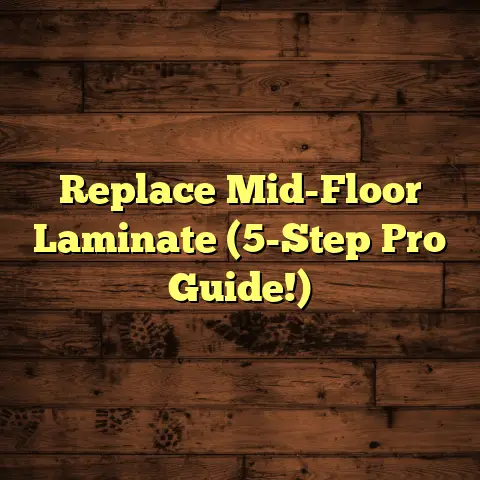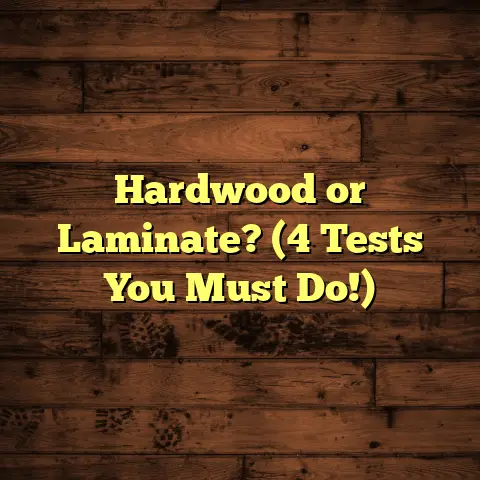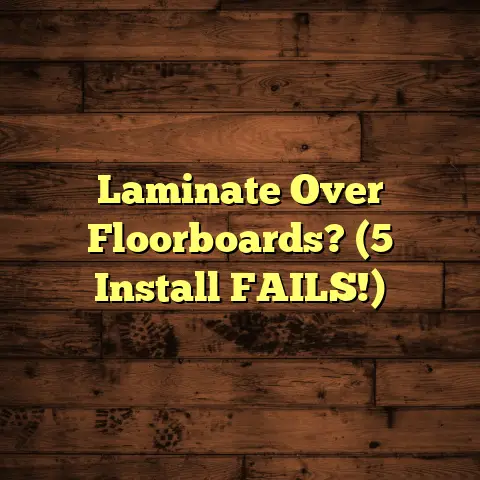Refinish Hardwood? (3 Tests Reveal NOW!)
But let’s be honest, life happens. Kids, pets, clumsy moments – they all take a toll. That beautiful sheen you once admired? It might be looking a little…tired.
That’s where refinishing comes in. It’s like giving your floors a spa day, stripping away the years and revealing the beauty that’s been hiding underneath.
But is refinishing the right move for your floors? That’s the million-dollar question. Before you even think about renting a sander, I want to share 3 simple tests I use as a flooring contractor.
These tests will give you a clear picture of whether refinishing is the best path forward. We’ll dive into the scratch test, the water test, and the shine test. Ready to unlock the secrets hidden in your hardwood? Let’s get started!
1. Understanding Hardwood Flooring
Before we get our hands dirty, let’s cover some basics about hardwood. It’s important to know what you’re dealing with.
1.1 Definition and Types of Hardwood Flooring
Okay, so what exactly is hardwood? Simply put, it’s flooring made from a single piece of wood. The two main types you’ll encounter are solid and engineered.
-
Solid Hardwood: This is the real deal, a solid piece of wood from top to bottom. It’s known for its longevity and the ability to be refinished multiple times.
-
Engineered Hardwood: This consists of a thin layer of real hardwood (the veneer) bonded to a core of plywood or high-density fiberboard. It’s more stable than solid hardwood, making it less prone to warping or cupping in humid environments. However, it can usually only be refinished a limited number of times, depending on the thickness of the veneer layer.
And then there’s the species. Oak, maple, hickory, cherry, walnut… the list goes on! Each species has its own unique grain pattern, color, and hardness.
Oak is a classic choice, known for its durability and versatility. Maple offers a cleaner, more modern look. Hickory is incredibly tough, perfect for high-traffic areas. And walnut? Well, walnut just oozes luxury.
1.2 The Natural Beauty of Hardwood
Why do people love hardwood so much? It’s more than just a floor; it’s a statement. Hardwood brings warmth and natural beauty to any room.
The unique grain patterns of each plank tell a story. The subtle variations in color add depth and character. And let’s not forget the satisfying feeling of walking on a solid, well-maintained hardwood floor.
I’ve seen hardwood floors completely transform a space. They can make a small room feel larger, a dark room feel brighter, and a cold room feel warmer. It’s an investment that pays off in both aesthetics and value.
1.3 Common Issues with Hardwood Flooring
Now, let’s talk about the not-so-pretty stuff. Even the most well-cared-for hardwood floors can develop problems over time. Here are some of the most common culprits:
-
Scratches: These are inevitable, especially if you have pets or kids. Surface scratches are usually cosmetic, but deep scratches can penetrate the finish and damage the wood itself.
-
Dents: Dropped objects, heavy furniture, and even high heels can cause dents. Like scratches, dents can detract from the overall appearance of the floor.
-
Discoloration: Sunlight, spills, and even certain cleaning products can cause discoloration. This can manifest as fading, yellowing, or staining.
-
Water Damage: Water is hardwood’s worst enemy. Leaks, spills, and high humidity can cause warping, cupping, and even rot. According to the EPA, moisture control is critical to preventing mold growth, which can be exacerbated by water-damaged wood.
These issues don’t necessarily mean your floors are beyond repair. But they do indicate that it might be time to consider refinishing.
2. The Refinishing Process
Okay, so you’re thinking about refinishing. Let’s break down what that actually entails.
2.1 What is Refinishing?
Refinishing is the process of sanding down the existing finish on your hardwood floors and applying a new one. It’s like hitting the reset button, revealing the fresh, untouched wood underneath.
It’s important to distinguish refinishing from other options:
-
Replacement: This involves completely removing the old flooring and installing new hardwood. It’s the most expensive and disruptive option.
-
Resurfacing (or Buffing and Recoating): This involves lightly sanding the existing finish and applying a new coat of finish. It’s a good option for floors with minor surface scratches, but it won’t address deeper issues like dents or discoloration.
Refinishing is the sweet spot. It’s more involved than resurfacing, but less drastic than replacement. It can address a wide range of issues and significantly improve the appearance of your floors.
2.2 Tools and Materials Needed
If you’re planning to DIY your refinishing project, you’ll need to gather the right tools and materials. Here’s a basic list:
-
Drum Sander or Orbital Sander: This is the big one. A drum sander is more aggressive and faster, but it’s also easier to damage the floor if you’re not careful. An orbital sander is more forgiving, but it takes longer.
-
Edger Sander: This is used to sand along the edges of the room and in corners.
-
Detail Sander: For those hard-to-reach spots.
-
Sandpaper (various grits): You’ll need different grits for each stage of the sanding process.
-
Wood Filler: For filling in any gaps or cracks.
-
Stain (optional): If you want to change the color of your floors.
-
Finish (polyurethane, varnish, etc.): This protects the wood and gives it a sheen.
-
Applicators (brushes, rollers, etc.): For applying the stain and finish.
-
Safety Gear (dust mask, safety glasses, ear protection): Essential for protecting yourself from dust and fumes.
2.3 Step-by-Step Refinishing Process
Alright, let’s walk through the refinishing process. Keep in mind that this is a general overview, and specific steps may vary depending on the condition of your floors and the products you’re using.
-
Preparation: Clear the room completely. Remove furniture, rugs, and anything else that might get in the way. Clean the floors thoroughly.
-
Sanding: This is the most crucial step. Start with a coarse grit sandpaper (e.g., 36-grit) to remove the old finish. Then, move to a medium grit (e.g., 60-grit) to smooth out the surface. Finally, use a fine grit (e.g., 100-grit) to create a smooth, even finish. Always sand with the grain of the wood.
-
Filling: Use wood filler to fill in any gaps, cracks, or nail holes. Let the filler dry completely, then sand it smooth.
-
Staining (optional): Apply the stain evenly, following the manufacturer’s instructions. Let the stain dry completely before moving on.
-
Finishing: Apply several coats of finish, allowing each coat to dry completely before applying the next. Lightly sand between coats to ensure a smooth, even finish.
-
Curing: Allow the finish to cure completely before putting furniture back in the room. This can take several days or even weeks, depending on the product you’re using.
Refinishing is a labor-intensive process, but the results can be amazing. If you’re not comfortable doing it yourself, it’s always best to hire a professional.
3. Test 1 – The Scratch Test
Now, let’s get to those tests I promised! First up, the scratch test.
3.1 Introduction to the Scratch Test
The scratch test is a simple way to assess the condition of your floor’s finish. It helps determine if the finish is worn down, damaged, or still providing adequate protection. A worn finish is more susceptible to scratches, dents, and water damage.
Think of the finish as a shield protecting the wood underneath. If that shield is compromised, the wood is vulnerable.
3.2 Conducting the Scratch Test
Here’s how to perform the scratch test:
-
Choose a Discreet Area: Select an area that’s not highly visible, like under a rug or in a corner.
-
Gather Your Tools: You’ll need a coin (a penny or nickel works well) or a fingernail.
-
Apply Gentle Pressure: Gently scratch the surface of the floor with the coin or your fingernail. Don’t apply excessive force.
-
Observe the Results: Look closely at the area you scratched. Did you leave a visible mark? Did you scratch through the finish to the wood?
3.3 Interpreting the Results
Here’s what the results of the scratch test can tell you:
-
No Visible Mark: If you can’t see any scratch or mark, your finish is likely in good condition.
-
Light Scratch in the Finish: This indicates that the finish is worn down, but the wood itself is still protected. You might be able to get away with a light buffing and recoating.
-
Scratch Through to the Wood: This is a clear sign that your finish is failing. The wood is exposed and vulnerable to damage. Refinishing is likely necessary.
I’ve seen homeowners put off refinishing after seeing a light scratch, only to end up with significant water damage later on. Don’t underestimate the importance of a healthy finish!
4. Test 2 – The Water Test
Next up, let’s talk about the water test.
4.1 Introduction to the Water Test
The water test helps you assess the water resistance of your floor’s finish. A healthy finish should repel water, preventing it from seeping into the wood. If water soaks in quickly, it’s a sign that the finish is compromised.
Remember what I said earlier: water is hardwood’s worst enemy. Prolonged exposure to moisture can lead to warping, cupping, and even rot.
4.2 Conducting the Water Test
Here’s how to perform the water test:
-
Choose a Few Areas: Select a few different areas of the floor, including areas that get a lot of traffic and areas that don’t.
-
Place a Few Drops of Water: Place a few drops of water on the surface of the floor.
-
Observe What Happens: Watch what happens to the water droplets. Do they bead up on the surface, or do they soak in quickly?
-
Time It: Time how long it takes for the water droplets to be absorbed into the wood.
4.3 Interpreting the Results
Here’s what the results of the water test can tell you:
-
Water Beads Up: If the water droplets bead up on the surface and don’t soak in, your finish is in good condition and is providing adequate water protection.
-
Water Absorbs Slowly (within a few minutes): This indicates that the finish is starting to wear down, but it’s still providing some protection. You might be able to get away with a light buffing and recoating.
-
Water Absorbs Quickly (within seconds): This is a clear sign that your finish is failing. The wood is exposed and vulnerable to water damage. Refinishing is likely necessary.
According to the National Wood Flooring Association (NWFA), properly finished hardwood floors should be able to withstand occasional spills and moisture. If your floors are failing the water test, it’s time to take action.
5. Test 3 – The Shine Test
Finally, let’s talk about the shine test.
5.1 Introduction to the Shine Test
The shine test is a simple visual assessment of your floor’s finish. A healthy finish should have a consistent, even sheen. A dull, uneven, or cloudy finish can indicate wear and tear.
Think of the shine as a reflection of the finish’s health. A vibrant shine indicates a healthy, well-maintained finish, while a dull shine suggests that the finish is starting to break down.
5.2 Conducting the Shine Test
Here’s how to perform the shine test:
-
Observe the Floor in Natural Light: Look at your floors in natural light. Pay attention to the overall sheen and any areas that appear dull, uneven, or cloudy.
-
Use a Flashlight (Optional): Shine a flashlight across the surface of the floor at a low angle. This can help highlight any imperfections or areas of uneven shine.
-
Compare Different Areas: Compare the shine in high-traffic areas to the shine in low-traffic areas. Is there a noticeable difference?
5.3 Interpreting the Results
Here’s what the results of the shine test can tell you:
-
Consistent, Even Shine: If your floors have a consistent, even sheen throughout, your finish is likely in good condition.
-
Dull or Uneven Shine: This indicates that the finish is starting to wear down. High-traffic areas may appear duller than low-traffic areas.
-
Cloudy or Hazy Appearance: This can be caused by a buildup of dirt, grime, or cleaning products. It can also indicate that the finish is starting to break down.
I’ve seen homeowners try to revive a dull finish with harsh cleaning products, only to make the problem worse. The shine test is a great way to gauge the overall health of your finish and determine if it’s time for a more comprehensive solution.
Conclusion
So, there you have it: the scratch test, the water test, and the shine test. These three simple tests can provide valuable insights into the condition of your hardwood floors and help you determine if refinishing is the right choice.
Remember, refinishing is an investment in your home. It can restore the beauty and value of your floors, while also protecting them from further damage.
Before you make a decision, take a good look at your floors. Perform these tests. Consider your budget and your DIY skills.
If you’re still unsure, don’t hesitate to consult with a professional flooring contractor. I always recommend getting a few quotes and asking plenty of questions.
Ultimately, the decision is yours. But armed with the knowledge you’ve gained in this article, you can make an informed choice that will keep your hardwood floors looking beautiful for years to come.
Now go forth and give your floors the love they deserve!





